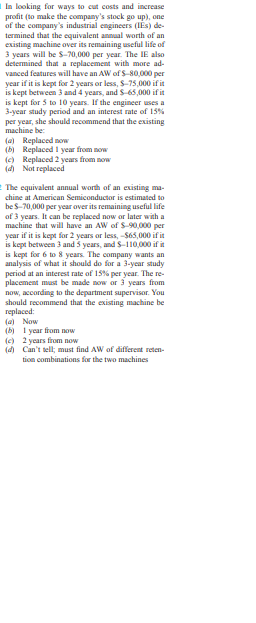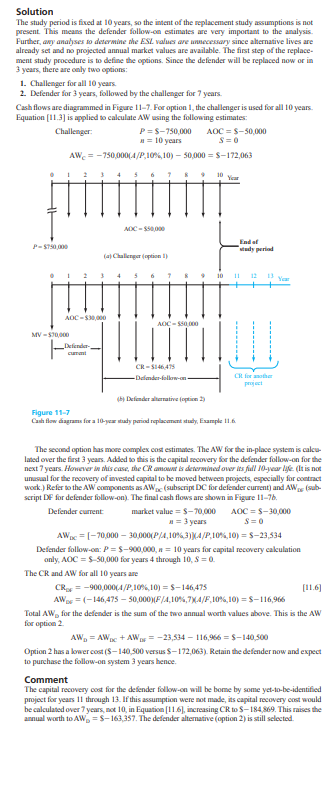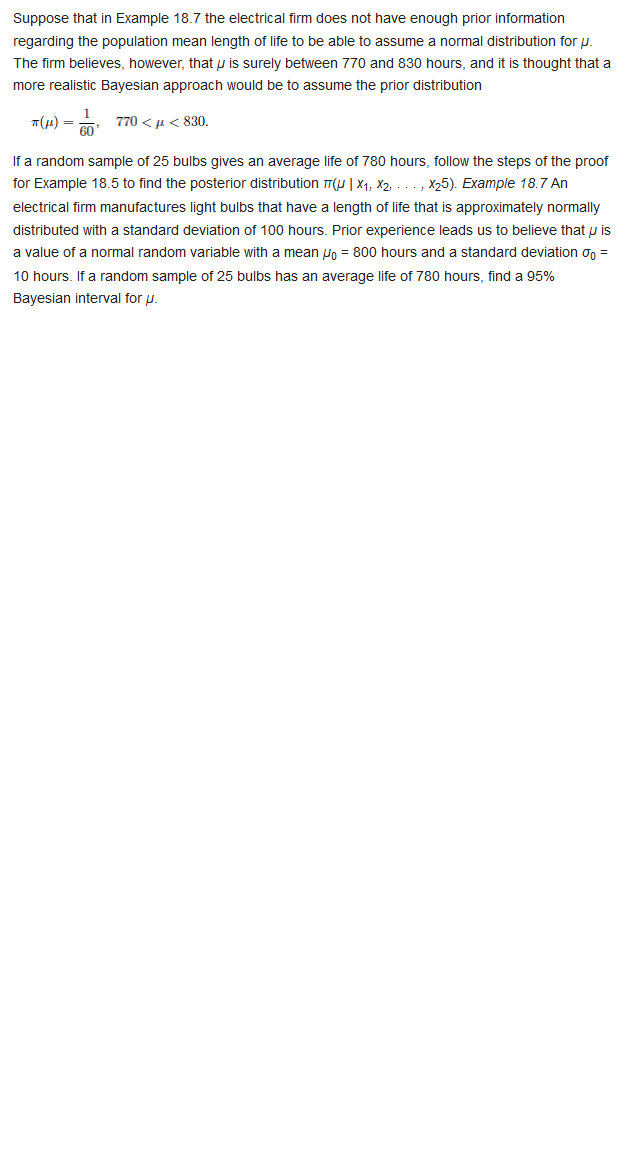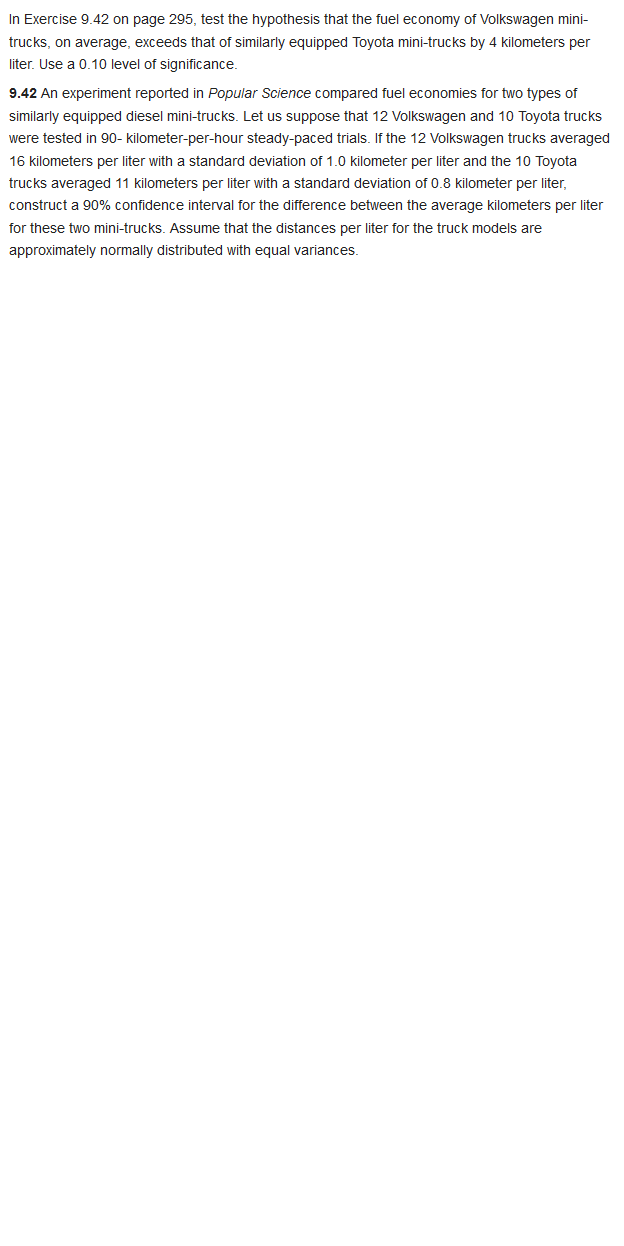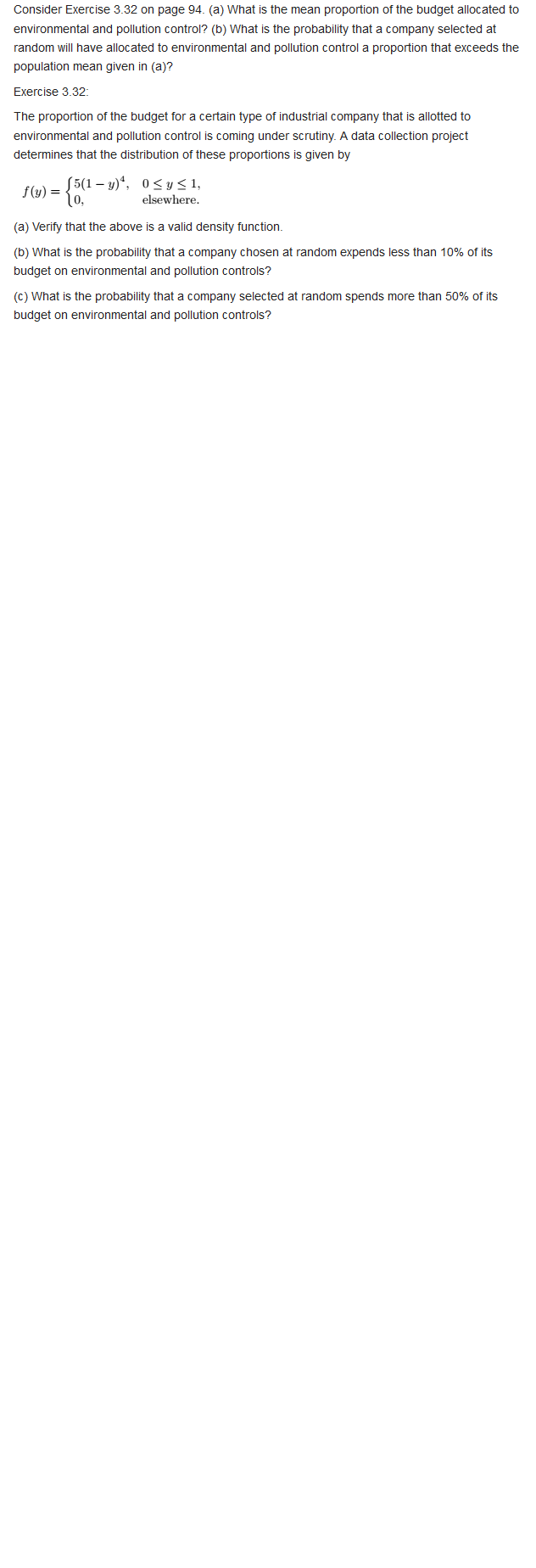Answer these
In looking for ways to cut costs and increase profit (to make the company's stock go up), one of the company's industrial engineers (IEs) de- termined that the equivalent annual worth of an existing machine over its remaining useful life of 3 years will be $-70,000 per year. The IE also determined that a replacement with more ad- vanced features will have an AW of $ 80,000 per year if it is kept for 2 years or less, $-75,000 if it is kept between 3 and 4 years, and $ 65,000 if it is kept for $ to 10 years. If the engineer uses a 3-year study period and an interest rate of 13% per year, she should recommend that the existing machine bbe: [a) Replaced now (5] Replaced I year from now (c) Replaced 2 years from now fa) Notreplaced The equivalent annual worth of an existing ma- chine at American Semiconductor is estimated to be $ 70,000 per year over its remaining useful life of 3 years. It can be replaced now or later with a machine that will have an AW of $ 90,000 per year if it is kept for 2 years or less, -$65,000 if it is kept between 3 and 3 years, and $-110,000 if it is kept for 6 to 8 years. The company wants an analysis of what it should do for a 3-year study period at an interest rate of 15% per year. The re- placement must be made now or 3 years from now, according to the department supervisor. You should recommend that the existing machine be replaced: (a) Now (5) 1 year from now (c) 2 years from now a) Can't tell; must find AW of different reten- tion combinations for the two machinesSolution The study period is fixed at 10 years, so the intent of the replacement study assumptions is not present. This means the defender follow-on estimates are very important to the analysis. Further, any analyses to determine the ESL values are unnecessary since alternative lives are already set and no projected annual market values are available. The first step of the replace- ment study procedure is to define the options. Since the defender will be replaced now or in 3 years, there are only two options: 1. Challenger for all 10 years. 1. Defender for 3 years, followed by the challenger for 7 years. Cash flows are diagrammed in Figure 11-7. For option I, the challenger is used for all 10 years. Equation [1 1.3] is applied to calculate AW using the following estimates: Challenger: P =$-750,000 AOC = $-50,000 # = 10 years S=0 AW, = -750,000(4/P,10%,10) - 507000 = $-172,063 10 ADC - $56000 End of study period fat Challenger |option IF 11 Year AOC -30 0U _Defender- current CR - 5146475 -Defender-fallow-an 4hy Defender alternative [option ?) Figure 11-7 Cash flow diagrams for a 10-year mudy period replacement study, Example II.6. The second option has more complex cost estimates. The AW for the in-place system is calcu- lated over the first 3 years. Added to this is the capital recovery for the defender follow-on for the next 7 years. However is this case, the CR amown is determined over its full 10-year Me. (It is not unusual for the recovery of invested capital to be moved between projects, especially for contract work.) Refer to the AW components as AWp (subscript DC for defender current) and AW (sub- script DF for defender follow-on). The final cash flows are shown in Figure 11-76. Defender current market value = $-70,000 AOC =$-30,000 a =3 years AWac = [-70,000 - 30,000(P/4, 10%,3) (4/P.10%,10) = $-23,534 Defender follow-on: P = $-900,000, a = 10 years for capital recovery calculation only, AOC = $-50,000 for years 4 through 10, 8 = 0. The CR and AW for all 10 years are CROF = -900,00014/P,10%%,101 = $-146,475 [11.6] AWDE =(-146,475 - 50,000)(F/4,10%,7)(4/F,10%,10) = $-116,966 Total AW, for the defender is the sum of the two annual worth values above. This is the AW for option 2 AW = AWac + AW = -23,534 - 116,956 =$-140,500 Option 2 has a lower cost ($-140,300 versus $-172,063). Retain the defender now and expect to purchase the follow-on system 3 years hence. Comment The capital recovery cost for the defender follow-on will be home by some yet-to-be-identified project for years 10 through 13. If this assumption were not made, its capital recovery cost would be calculated over 7 years, not 10, in Equation [1 1 6], increasing CR to $-184,869. This raises the annual worth to AW,, = $-163,357. The defender alternative (option 2) is still selected.\f\f\f
